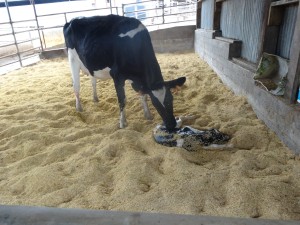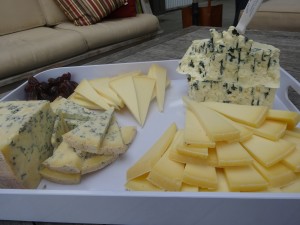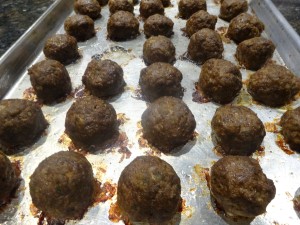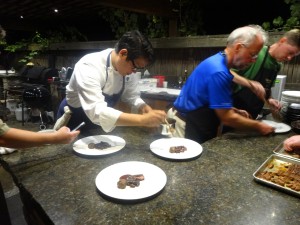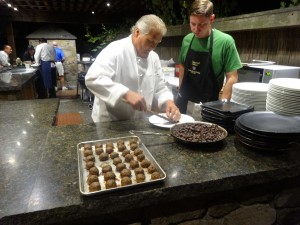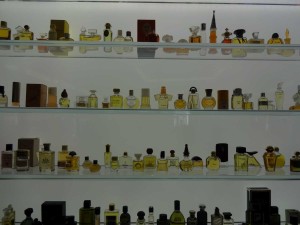Today is our last full day of the Cakebread Cellars American Harvest Workshop. After a very long day of picking grapes, making pottery and cooking dinner for 65 yesterday, we’re up early again, gathering at 6:30 am for a drive to the coast. We’re visiting three artisan purveyors, Point Reyes Farmstead Cheese Company, Hog Island Oyster Company and Della Fattoria, a bakery, and in my opinion the best bakery in the United States. I love their pumpkin seed and polenta breads. I have been to all of these places, on video shoots when I was producing the TV show In Wine Country. But I was always working and didn’t experience it as a regular visitor might.
It’s about a 90 minute drive from Napa Valley to Point Reyes Farmstead Cheese, in the Point Reyes National Seashore. While the marine layer is thick this morning, the scenery, with the water and rolling hills is beautiful. This is the perfect pastoral for a dairy farm famous for blue cheese. We were lucky enough to arrive just as a calf had been born and watched with wonder how soon the calf would soon stand.
Point Reyes cow dairy was founded in in 1959 by Bob and Dean Giacomini. They sold all their milk until the family decided to finally start making cheese in 2000. They did research and found no other dairy making blue cheese in California, so they decided that’s what they would do. People in the cheese industry thought they were crazy to base their cheese business on one cheese, a raw milk blue cheese, the hardest cheese to make. But they persevered and Point Reyes Original Blue is now in demand nationwide.
Bob leads us on a tour around the dairy. We get to see a calf that was born a mere 10 minutes earlier being licked by its mother and being encouraged to stand up. Come on you can do it! Bob tells us he has a herd of 340 dairy cows producing about 9000 pounds of cheese a year. One gallon of milk is 1 pound of cheese; each cow produces about 9.5 gallons of milk per day, or 9.5 pounds of cheese a day. He’s a practical farmer and explains how they are about as big as they want to be; why organic dairy farming isn’t the best choice for them and knows just about everything about a dairy cow you’d ever want to know. They are what he calls a “closed herd” which means they don’t increase their herd by bringing in animals from outside their ranch. They breed what they need from their own herd. It’s a way to keep disease at bay and know where your cows are coming from. This makes me want to keep buying their cheese more often (a favorite of mine, I will become a more loyal customer now). The chefs are certainly impressed and I think we’ll be seeing Point Reyes Original Blue and the other cheeses they produce offered on the menus at their restaurants.
I didn’t know Point Reyes had diversified beyond Original Blue. They now make a wonderful fresh mozzarella, and gouda-like cheese called Toma, which is smooth and creamy, and then a new blue called Bay Blue which unlike Original Blue which is very creamy is more crumbly, has a grainy texture and is a little sweeter. It’s aged three months vs five months for Original Blue. We get to taste all of the cheeses on the patio of the culinary center at the dairy, called The Fork, where you can also take cooking classes.
It’s hard to get us to leave — I feel for Brian, having to wrangle all of us and pull us away from this fascinating visit, but we have places to go and more food to try. The next stop is just down the road at Hog Island Oyster Company. As soon as I get there I breathe in and smell the brine of the water, the brine that I tasted in the oysters we prepared and served last night. Everyone is excited to be here, a breathtaking spot on Tomales Bay. There’s tons and tons of oysters being sorted; we get a lesson on the life of an oyster and how they are farmed. These folks are as passionate about growing the best tasting and healthiest oysters they can, and it is amazing to hear all the regulatory reporting and controls that go into being an oyster farmer. Makes you feel pretty confident about eating their oysters. We slurp a few up and head out again, destination Della Fattoria.
This may be the most eclectic bakery anywhere. We’re not at Della Fattoria’s storefront in downtown Petaluma; we’re at the actual production bakery which is at the home of the founding bakers. Their kids who also work in the family biz, live next door now and they all share an amazing garden and outdoor dining space, filled with vegetable gardens, art, cats and funky knickknacks. It’s too bad we aren’t here when they are actually baking bread; I’ve been here to see that an it is an amazing show. And there’s nothing better than the smell of bread baking. There is work going on — bakers are shaping loaves for the next batches. They do it so quickly, and the dough looks so soft and supple.
We’re treated to a simple, but amazing lunch of sandwiches – veggie, turkey and BLT all on Della Fattoria bread, plus a big fresh garden salad. Of course there are Cakebread wines to go with it. It’s a relaxing meal and none of us want to leave this idyllic spot. But there is work to be done in the kitchen and dinner to serve tonight.
When I get to the Cakebread kitchen at 3:30 pm Chef Jim Severson has already started his Scarlet Runner Beans from Rancho Gordo. Our dish features lamb from the Napa Valley Lamb Company. Owner Don Watson personally brings us two 35 pound lambs to butcher for the meal; he graciously offers to break them down for us. We’re roasting the lamb loin with a spice rub that has chili lime salt, roasted garlic powder, salt, pepper, and cumin – its delicious. Then we’ll make albondigas, a Mexican meatball. As Jim says, this will be a taste of Texas. We’re also making a sauce reduction that has the Cabernet that we’re pairing the dish with in it, again to act as a bridge between the wine and food.
This is my first time doing any butchering, taking off the silver skin and fat. I also have to work with micro cilantro, not my choice of herbs because it tastes soapy to me and ruins everything. I also help with the passed hors d’oeuvres that we’re making, crostini with Bay Blue cheese from Point Reyes, with apples cooked in a rich slightly sweet sauce that will top the cheese. So I get the bread toasted, smear on the cheese and work on plating it and sending it out.
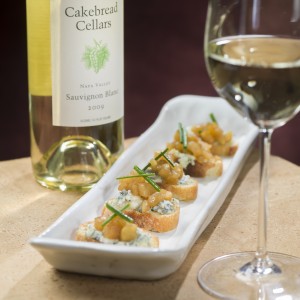
There’s no stopping today, it’s a lot more work than we did yesterday, but it is super fun. Again Jim is showing me and our team everything he is doing and has us taste along with him. He asks our opinions on flavors and seasoning. We keep tweaking until we get it right. There is no recipe! Jim tells me he was super nervous for the first night’s dinner, and tonight’s dinner kept him up all night until he figured out how he would approach the lamb. Biggest thing is he doesn’t want to screw up the raw ingredients or the wine. But now he’s in his groove and the dish is really coming together. I love the subtle spiciness in the albondigas and can’t wait to see the finished dish on the plate.
We’ve moved to the outdoor kitchen to finish cooking the lamb and plate. It’s all hands on deck when it comes time, and the chefs who finished before us are pitching in too. The plates come fast and furious, each looking like the one before it. I’m super proud of it and I hope Jim is too. The night’s meal is even better than last night’s; chef Eric makes the best duck I have ever had, and I love our lamb dish, wish I had more meatballs!

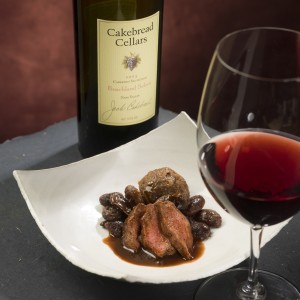
Day 5
We don’t have to gather until 9 am today, and when we do, we arrive at the Cakebread winery to find the power is out. There must be a desperate scramble in the winery with grapes coming in from the night’s picking. Chef Brian and his staff manage to put together a wonderful breakfast anyway, with scrambled eggs topped with sauteed mushrooms from Gourmet Mushrooms, more papaya and granola and yogurt. Another feast to end our week here.
We talk about the program, what we liked, make suggestions for next year and then say our goodbyes. It is clear that everyone has enjoyed the workshop and learned a tremendous amount about not just food and wine, but gardening, birds of prey and pottery. We all leave with new friends too, and I look forward to visiting the chefs’ restaurants when I travel. Quite the well-rounded experience, not exactly what I was expecting but so much better. I can’t wait to go home and share what I’ve done with my family and friends.
Now I understand why the American Harvest Workshop has been going strong for 27 years and why people come to take part, and return year after year. You learn and do so much, with lots of encouragement along the way, and you see how wine and food really do bring people together, not just around the table but in day to day business and in helping each other thrive.

